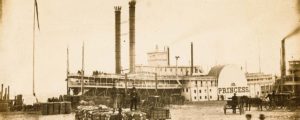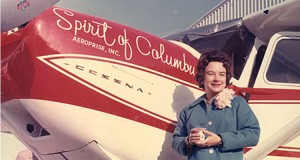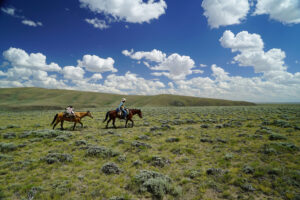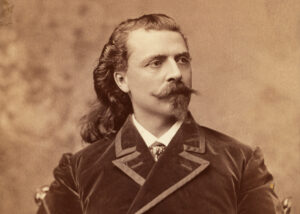Yes, Virginia City, there is a Santa Claus.
On Christmas Day 1863 in Virginia City, Nevada, Mark Twain received a gift from a Miss Chase. “The diabolical box had nothing in it but a ghastly, naked, porcelain doll baby,” newspaperman Twain wrote in the Virginia City Territorial Enterprise.
“However, we are much obliged—we always had a hankering to have a baby, and now we are satisfied. The mythical ‘Miss Chase’ helped us to the business, and she has our cordial thanks for her share in it.” An annual December treat of a different sort in today’s Virginia City is its Christmas on the Comstock Parade, in which the original oil lamps from the 1800s are lit to add a frontier touch to all the Christmas lights.
Virginia City, Mont., also has a long Christmas tradition. “Christmas Day 1865 was a memorable day in Virginia City in the Territory of Montana,” wrote Jesuit Father Francis X. Kuppens (1839-1916) late in life. He went on to describe how glad tidings were spread in a theater, the largest place in that new capital city, so that Father Joseph Giorda (1823-92) could give a High Mass at midnight on Christmas Eve. “At the time of the discovery of gold at Last Chance gulch there has been a great stampede, but the Christmas preparations appeared more stirring,” Kuppens wrote. A packed house of Catholic gold miners and others attended the service, and so much gold went into the collection plate that the building could be obtained “free without debt, as an abiding place dedicated to God forever.” Today, tiny Virginia City (Helena replaced it as the capital in 1875) sponsors the Virginia City Christmas Socials and Market, a monthlong celebration of concerts and festivities with a 19thcentury Christmas theme.
The 1860s Virginia City Christmas celebrations in Nevada and Montana Territory were nothing new on the Western frontier. The tradition of lighting small bonfires, called luminaries, to guide Catholics to Midnight Mass on Christmas Eve was brought by Franciscan monks from Spain to Old Mexico in the 16th century, and the Spanish eventually carried the custom north into what would become New Mexico. By the early 19th century, New Mexico residents had replaced the bonfires with paper lanterns from China or lanterns made at home with paper sacks. Christmas Eve continues to be a big deal in the state, with many places (such as Old Town in Albuquerque) turning off all electric lights and displaying flickering candlelights in brown paper bags—still called luminaries or else farolitos (Spanish for “little lanterns”).
Meriwether Lewis, William Clark and the other members of the Corps of Discovery celebrated Christmas in 1804 at Fort Mandan (in future North Dakota) by raising the American flag, shooting off guns and drinking a lot of brandy. “None of the natives came to the garrison this day; the commanding officers having requested they should not, which was strictly attended to,” Corps member Patrick Glass wrote in his journal. Missionaries spread the Christmas word in the years that followed. A Presbyterian missionary, Henry Wilson, was delighted to find 100 Cherokee families, not yet converted, celebrating Christmas in Indian Territory (present-day Oklahoma) in 1832. “This,” he later wrote, “was the happiest Christmas I ever spent, though far from home and friends and destitute of the luxuries and comforts to which I have become accustomed.” Jesuit missionary Father Pierre Jean De Smet brought Christmas to Indians in future Montana, Idaho and Washington. “The great festival of Christmas, the day on which the little band was to be added to the number of the true children of God, will never be effaced from the memory of our good Indians,” De Smet wrote after an 1844 Christmas celebration with some Kalispels (also known as Pend d’Oreilles).
Later, of course, soldiers, prospectors and settlers brought yuletide traditions to the Great Plains and Rockies. Soldiers at Camp Arbuckle (near presentday Purcell, Okla.) in 1855 might have been far away from their families on Christmas, but they ate well; their Christmas dinner included a wide variety of meat—bear, buffalo tongue, venison, prairie hen, wild turkey, goose, duck, quail and pigeon.
The mining camp of Denver City was just over a month old when Christmas arrived in 1858, not in the form of Santa Claus, but one Richens Lacy Wootton. The New Mexico merchant showed up on the morning of December 25 with a barrel of Taos Lightning. “Uncle Dick gave the whole town a free blowout,” said participant A.E. Pearce. “Everyone helped himself freely, using tin cups.” All that potent moonshine led to singing and dancing and more drinking around a bonfire—a Christmas tree was even decorated at one of the cabins—but the religious service planned by Methodist Reverend George W. Fisher was apparently canceled.
A 21-year-old New York newspaperman, William Lawrence “Larry” Chittenden, attended a Cowboy Christmas dance at the Star Hotel in Anson, Texas, in 1885 and made it famous with an 1890 poem, “The Cowboys’ Christmas Ball.” Four of the more famous lines read:
Where lonesome, tawny prairies melt into airy streams,
While the Double Mountains slumber, in heavenly kinds of dreams;
Where the antelope is grazin’ and the lonely plovers call—
It was there that I attended “The Cowboys’ Christmas Ball.”
The poem became a song, and it was recorded in 1985 by history-minded musician Michael Martin Murphey. The Texas Cowboys’ Christmas Ball remains an annual event in Anson; Murphey will be there on December 21, 2007. “Cowboys’ Christmas Ball” has also become a trademarked touring show, with Murphey and his band performing in many other cities during the holiday season. Don’t go expecting any Taos Lightning, however. These Christmas celebrations are alcohol free.
Editor Gregory Lalire has spent some relatively modern Western Christmases in Albuquerque,N.M.,Hobbs,N.M.,Missoula,Mont., and Las Cruces, N.M. Suggested for further reading: Christmas in the Old West: A Historical Scrapbook, by Sam Travers.
Originally published in the December 2007 issue of Wild West. To subscribe, click here.




